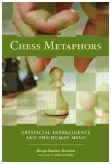Of all the top grandmasters who could give their views of chess-playing computers, Garry Kasparov is probably the best qualified. He has played several matches against computers at a time when programmers were trying with all their might to make a computer that would defeat a world champion.
In his review of Chess Metaphors: Artificial Intelligence and the Human Mind, Kasparov makes several interesting observations about the affect computers have had on humans who play chess.

Kasparov recently wrote a review of Chess Metaphors for the New York Review of Books (see link below), and in it he says some interesting things about his view of computers conquering chess.
The Chess Master and the Computer – The New York Review of Books
The number of legal chess positions is 1040, the number of different possible games, 10120. Authors have attempted various ways to convey this immensity, usually based on one of the few fields to regularly employ such exponents, astronomy. In his book Chess Metaphors, Diego Rasskin-Gutman points out that a player looking eight moves ahead is already presented with as many possible games as there are stars in the galaxy. Another staple, a variation of which is also used by Rasskin-Gutman, is to say there are more possible chess games than the number of atoms in the universe. All of these comparisons impress upon the casual observer why brute-force computer calculation can’t solve this ancient board game. They are also handy, and I am not above doing this myself, for impressing people with how complicated chess is, if only in a largely irrelevant mathematical way.
* * *
There have been many unintended consequences, both positive and negative, of the rapid proliferation of powerful chess software. Kids love computers and take to them naturally, so it’s no surprise that the same is true of the combination of chess and computers. With the introduction of super-powerful software it became possible for a youngster to have a top- level opponent at home instead of needing a professional trainer from an early age. Countries with little by way of chess tradition and few available coaches can now produce prodigies. I am in fact coaching one of them this year, nineteen-year-old Magnus Carlsen, from Norway, where relatively little chess is played.
If you’re interested in the entire review, click the link above.
If you’re interested in the book Kasparov reviewed, you can get it from my Chess Store here.

Yes, computers have had a huge impact. Not just on the availability of top level opponents, but also in the ability to investigate positions. I generally play Byrd’s opening with white and I was confronted with a defense I had never seen before by the computer. It tore my attack completely apart. I plugged it into ChessBase and soon had seen many variations on the theme and also some good ways to counter black’s gambit. It is a great resource.
I agree completely. ChessBase is great, and I highly recommend it. Thanks for your comment.
I wonder if there’s anyone that thinks ahead more moves than the computer…
What’s ChessBase?
Join us tonight for the Kick-Off Fundraiser for the KARPOV2010 Campaign!
Goal: to elect the twelfth world chess champion, Anatoly Karpov, as President of the World Chess Federation (FIDE). The party will take place on Monday May 17th at the Trump Soho in New York.
See here for details: http://karpov2010.eventbrite.com/?utm_source=JANERA.com+Members&utm_campaign=17b23ff0b2-Climate+Change+Review&utm_medium=email
Click here for to see how you can watch a webcast of the event:
http://fora.tv/live/janera/Karpov_Kasparov_Carlsen
I love it!
Where did you learn about this? Can you give me the reference?
Sent from my iPad 4G
The documentary is a waste of time. Reading the Wikipedia enrites for Kasparov and Deep Blue are more informative and more interesting. However, there is one bit of interesting bonus material on the DVD: A move-by-move account of each game in the match, with analysis. It’s computerized, but interesting, especially the last game where Kasparov gets killed in 19 moves.